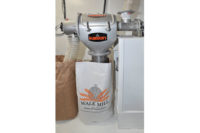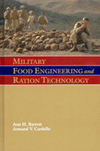Engineering R&D
Lubrication keeps wheels turning in flash freezing applications
For the meat packing industry, lubrication for conveyors must maintain adequate lubricity in freezing cold areas, provide corrosion resistance and be safe to use.

Dr. Jeremy Adler, Birko director of technology and innovation

The patent for Birko Frostlube describes an improved lubricant for use with a conveyor in a meat packing plant meeting the requirements of adequate lubricity, drip resistance, safety, rust resistance, economy of manufacture and use, and the ability to be removed by cleaning methods. Source: US PTO.


Pork processing, like any live protein processing, is not a nice environment for humans or machines. Humans, however, can dress properly or take breaks, but that isn’t the case for machinery, especially gambrels and rail surfaces on overhead conveyor systems. This machinery must run in hostile, cold environments—and keep on running.
Unfortunately, finding lubrication that survives a pork processing environment, especially blast freezers, hasn’t been easy. But now, Birko Corporation is offering a product line for pork processing applications including hog scalding, defoamer agents, pathogen reduction treatments and chemistries for gambrel cleaning and oiling.
The lubrication solution, known as Frostlube, is designed for the gambrels and rails in blast freezing applications. It received a US patent (8716205) last year. We caught up with Dr. Jeremy Adler, Birko’s director of technology and innovation, and asked him for some specifics about the product.
FE: The patent attributes Terry L. McAninch of Birko as the inventor. Can you tell us a little about his background?
Dr. Jeremy Adler: Terry is the current vice president of research and development at Birko. He has worked for Birko for 41 years, during which he has authored or co-authored 11 issued patents. He is truly the foundation of Birko’s R&D efforts and an industry expert in cleaning, sanitation and lubrication.
FE: How did you come to develop this lubrication?
Adler: A majority of our R&D projects come directly from identifying customer problems and trying to solve them. In this instance, we had a customer that was losing significant trim yield on hog carcasses because black specs had to be trimmed from the carcasses. Upon investigation, we realized the black specs were iron particles from the gambrels that spalled [chipped or flaked] onto carcasses after passing through the blast freezer. This spalling is caused when water adheres to a gambrel and freezes solid during blast freezing. The freezing of the water spalls iron flakes off the gambrel and onto the carcasses.
FE: What special lubrication problems needed to be solved?
Adler: Gambrels in a hog plant are cleaned and lubricated between uses. For the lubrication step, oil is floated on top of a water bath. Floating the oil on the water bath decreases the amount of oil needed for lubrication, saving the plant money. During the lubrication process, the gambrel is dipped into the tank passing through the oil layer and into the water. The gambrel is then passed through the oil layer again as it is raised out of the tank. It is then blow-dried to remove excess oil. Any water from the lower layer of the lubricating bath that is not displaced by the oil remains on the gambrel. This residual, or undisplaced water, can lead to gambrel spalling. Our goal was to find an oil mixture that would displace the water on the gambrel to minimize the amount of spalling. After several trials in the lab, we formulated Frostlube, which contains the precise amount of silicon oil to preferentially adhere to metal to displace water.
FE: How do you balance real-world lubrication needs with food safety requirements?
Adler: When formulating oils for lubrication, we use only products approved for incidental food contact. Given this, from a chemistry standpoint, there are really no food safety issues, as long at the product is applied as directed. Ultimately, Frostlube decreases the amount of trimming during the visual inspection of a carcass, increasing carcass yields.
FE: What level of viscosity should a lubrication treatment have for gambrel/rail applications?
Adler: We tend to define our gambrel and trolley lubricants by their lubricity and load-bearing properties. Lubricity is the lubricant’s ability to reduce friction, thus making it easier to move the loaded gambrel along the rail. The friction can be between the rail and the gambrel wheel or the gambrel wheel and central axis pin as the gambrel travels along the rail. The load-bearing capacity is the lubricant’s ability to adhere and remain on the surface to hold, or separate, the gambrel weight from the rail. Therefore, a lubricant’s load-bearing capacity is directly proportional to the viscosity. We design our lubricants to have the necessary load-bearing capacity and lubricity for the carcass weights and range of temperatures found in the processing environment.
FE: How does a lubricant’s viscosity change depending on environmental temperatures?
Adler: In general, the viscosity of fatty acid and mineral oils, which are [used in] the most common type of food industry lubricants, increases as the temperature is lowered. However, silicon oils tend to have a viscosity that is less affected by temperature to the point where they are almost temperature independent in the range of temperatures found in processing environments. Simply put, silicon oils stay fluid during pork processing at 180°F and even during blast freezing at -28°F.
FE: How do you keep the lubrication from dripping onto the carcass immediately below it?
Adler: The key is to develop a lubricant that does not thin out and drip. To inhibit dripping, we have incorporated an oil thickener into the formula of Frostlube. Additionally, we formulated the lubricant so it is thick and unlikely to drip at pork processing temperatures. For the oil to be applied quickly and uniformly, it must be applied hot. The lubricant application tank I previously described is around 180°F. After application, the oil’s temperature drops, and it forms a gel on the gambrel.
FE: How do you create a formula safe for incidental contact with meat?
Adler: We use only products approved by FDA and USDA for incidental contact with food, specifically, in this case, pork. If our lubricants come in contact with an edible product, that product is still safe to consume. Nonetheless, when a lubricant does come into contact with an edible product, USDA inspection procedures dictate that the product must be trimmed to remove the lubricant. FDA and USDA approval makes choosing the lubricant components easy: Either they are OK or not OK to use. However, it also limits the choice and possible functionality of the lubricant.
FE: When it’s time for washdown, does the lubricant stay put, or does it need to be reapplied?
Adler: Gambrels are cleaned and oiled between uses. The cleaning process is dependent on the gambrel metal composition and usually includes a cleaning agent applied at a high temperature. These cleaning processes, whether the plant is using steel or aluminum gambrels, clean the gambrels including the lubrication. Then, the gambrels are oiled before they are used again.
FE: Would this lubrication technology be suitable for gambrel/rail conveyor systems in other food applications?
Adler: Yes, Frostlube can be used in poultry and beef processing plants. But, since these plants do not use blast freezers and, for the most part, don’t have spalling issues, they would not experience the technical benefit of the lubrication.
FE: Are there any similar products on the market?
Adler: Frostlube was designed specifically for a pork processor that uses a blast freezer before cooling carcasses. We are unaware of any similar products in the poultry, beef and pork markets. It is patented technology, so we can protect this product for several years.
Looking for a reprint of this article?
From high-res PDFs to custom plaques, order your copy today!











